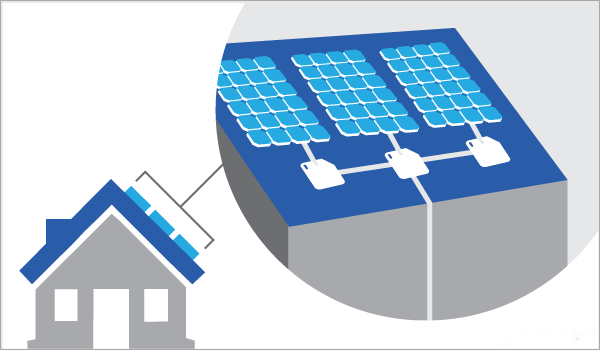What are Microinverters?
Micro inverters, as opposed to centralized string inverters in a solar energy system, are tiny inverters attached to each individual solar panel in a solar panel system. There are different types of microinverters, but the most common use is a 1:1 relationship with one micro inverter for each individual panel.
Because each micro inverter operates independently of the others in the system at the panel site, micro inverters are categorized as Module-Level Power Electronics (MLPE). For difficult installations or those with minimal shading, MLPEs are the best solution. With conventional string inverter technology, panels can only produce power at the level of the lowest-performing panel in the same string. With micro inverters, this isn’t an issue because each panel has its own inverter, so the solar panels continue to work efficiently even if one of the panels in the system isn’t producing energy.
The size of each micro inverter is determined by the size of the panel and the amount of energy it can produce (which depends on your location, tilt, and orientation, among other factors). Clipping occurs when your solar panel generates more electricity than its micro inverter can convert at any given time, resulting in power losses.
When to use Microinverters?
There are several reasons to consider installing micro inverters. Firstly, they allow you to monitor the performance of individual panels. With micro inverters, you can compare the performance of each panel on its own, rather than analyzing the system as a whole. This can lead to faster equipment servicing, as it is easier to identify if a particular panel or micro inverter is malfunctioning.

Microinverters are also an excellent choice for more complex installations with panels facing in different directions or tilted at different angles. If you have some panels facing east and some facing south, using microinverters on each panel will allow them to perform to their full potential when sunlight hits them, as they will not be affected by production problems that other panels in the system may suffer.
Microinverters are often more expensive than other types of inverters. The extra upfront cost may be worth it for the increased monitoring and production benefits. A lower-cost string inverter system may be an excellent alternative if you have a simple installation on a single south-facing roof with no shading.
The Advantages of Microinverters
Microinverters bring several advantages to solar power systems. Firstly, they offer increased energy production as each microinverter works independently, optimizing the output of each solar panel. This means that shading or performance issues with one panel do not affect others, maximizing overall energy generation. Additionally, microinverters provide panel-level monitoring, allowing for real-time system performance analysis and easy identification of any issues. They also offer enhanced safety with their built-in safety features, such as rapid shutdown capabilities during emergencies. Microinverters are also more flexible and scalable, making them suitable for different system sizes and configurations. Lastly, their modular design simplifies installation and maintenance, reducing costs and time.
Post time: Jul-28-2023